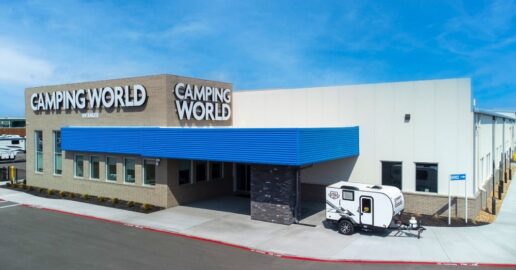
Camping World President and CEO Marcus Lemonis said the dealership will accept potential fourth-quarter financial losses to clear its stores of aged inventory.
Lemonis said Camping World had over 16,000 RVs from the 2022 model year to start 2023. Today the dealership has fewer than 100. Camping World stores have fewer than 11,700 RVs from the 2023 model year and Lemonis expects the total to drop around 9,000 by the end of 2023.
“With the new model year 2024 quickly arriving,” Lemonis said, “the cost of those units in our core segments are coming in more than 12% less. We must remain steadfast in this model year elimination strategy.”
Calling the company’s plan an “executive of rigorous inventory management,” Lemonis warned shareholders the company’s fourth-quarter earnings could be flat or slightly negative.
“Our investment in (the inventory management strategy),” he said, “our team feels is absolutely necessary.”
Lemonis highlighted the company’s Good Sam F&I results. He said Good Sam will exceed $100 million in business contributions for the first time in Camping World’s history. Strong sales in roadside assistance, extended warranties and vehicle insurance have driven profits.
Used RV sales in the third quarter of 2023 totaled 17,000, a company record for third-quarter used RV sales.
Chief Operating Officer Matthew Wagner highlighted Camping World’s work with OEMs to drive 2024 model introductions at lower price points.
“Over the last few months,” Wagner said, “we have worked extensively with our key manufacturing partners such as Thor, Forest River and Winnebago to identify segments and price points that will yield a greater volume of new RV sales while maintaining healthy margins.”
As the dealership group has opened and bought new locations in 2023, the company also is closing underperforming stores. In the third quarter, Camping World closed two retail stores and a distribution center. Seven more stores will be closed in the fourth quarter. By the end of the third quarter, Camping World laid off over 1,000 employees.
“The willingness to take decisive action and mobilize quickly to execute,” Lemonis said, “is what makes our management team and our company unique, nimble, decisive and effective.”
Lemonis highlighted Camping World’s strategy of supporting its workforce, saying earnings growth will not come at the expense of firing workers.
“We are struggling right now between the balance of holding on to what we believe is the best talent in America and compressed margins,” he said. “As a management team, and we understand that we may get beat up a little bit for this, we believe more in investing in our people and holding on to our people and providing better wages for our technicians and better wages for our management.
“We have renegotiated leases,” Lemonis continued. “We have eliminated locations. We all collectively have been successful in that. We do not want anybody to leave this call thinking that we are going to make more money on the backs of our people. We are going to make more money by driving revenue and then adding costs back in on the people side in a more variable way.”
Another Camping World management focal point is lowering the dealership’s average sales price (ASP). Lemonis said over the next quarter or two, Camping World wants to drive its ASP from the current $43,000 to about $38,000.
Although the strategy will bring less revenue from RV sales, Lemonis said Camping World will sell more RVs and thus increase sales in F&I products, Good Sam memberships, service repairs and parts/accessories sales.
“I think when you look at overall inventory across the entire channel, we are probably slightly under stock from where we need to be,” Lemonis said. “The key to that 370,000 (2024 wholesale RV shipment) number in our opinion … is understanding that ASPs need to be driven down. The way you drive ASPs down is you drive actual cost of production down.”
He said lowering production cost should not come at the cost of removing features and benefits consumers desire.
“I want to be clear that both the dealers and the manufacturers are not going to just drive ASPs down by de-contenting,” Lemonis said. “The customer, the consumer, cannot be the loser in that equation. Efficiency, proper forecasting, proper ordering—both on the raw material side and the dealers taking them—is the key to that.”
Finally, Lemonis said consumers’ purchase pullback due to rising interest rates has not affected credit availability.
“We have not seen any modification at this point in the availability of credit,” he said. “We have not seen that at all. We have seen consumers pause a little bit more when they look at the rate, particularly on a more expensive asset. As we have lowered the prices and as we brought in new lower ASPs, that has relieved itself a little, but we are not naive to the challenge that is out there of a consumer looking at a much higher rate than they did three years ago. Maybe they are accepting it a little bit more, but we are not taking it lightly.”




